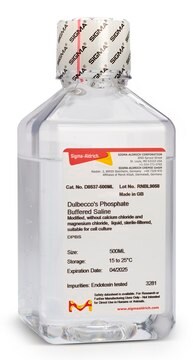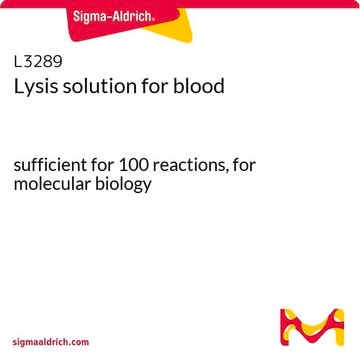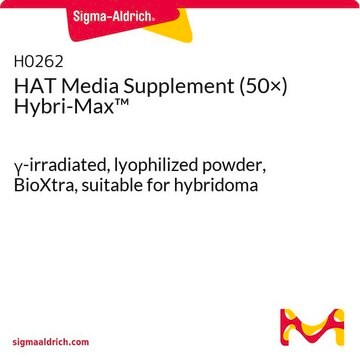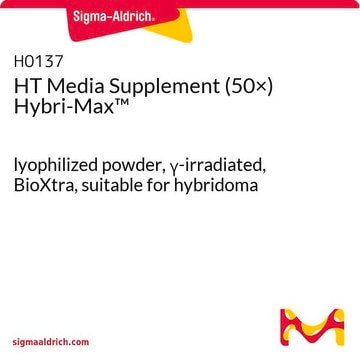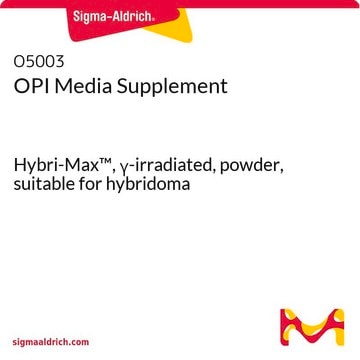Transportation information can be found in Section 14 of the product's (M)SDS.To access the shipping information for this material, use the link on the product detail page for the product.
R7757
Red Blood Cell Lysing Buffer Hybri-Max™
Liquid, sterile-filtered, suitable for hybridoma
Sinónimos:
RBC Lysing Buffer
Seleccione un Tamaño
Seleccione un Tamaño
About This Item
Productos recomendados
Nombre del producto
Red Blood Cell Lysing Buffer Hybri-Max™, liquid, sterile-filtered, suitable for hybridoma
sterility
sterile-filtered
Quality Level
form
liquid
technique(s)
cell culture | hybridoma: suitable
impurities
endotoxin, tested
Application
Biochem/physiol Actions
Components
Other Notes
Legal Information
Storage Class
12 - Non Combustible Liquids
wgk_germany
nwg
flash_point_f
Not applicable
flash_point_c
Not applicable
Elija entre una de las versiones más recientes:
¿Ya tiene este producto?
Encuentre la documentación para los productos que ha comprado recientemente en la Biblioteca de documentos.
Los clientes también vieron
-
What is the Department of Transportation shipping information for this product?
1 answer-
Helpful?
-
-
Is the BSA standard supplied with Product B6916, Bradford Reagent?
1 answer-
No, we do not supply the BSA standard with this reagent. We recommend using one of the following products: Protein Standard (BSA) Solution, (2 mg/mL), Product No. P0834 or Protein Standard (BSA) Solution, (1 mg/mL), Product No. P0914, if lower concentrations of protein are to be measured.
Helpful?
-
-
Can Product R7757, Red Blood Cell Lysing Buffer Hybri-Max™, be used to lyse cells that are trapped in whole tissue preparations?
1 answer-
Unfortunately, we have not verified the suitability of this lysis buffer for using with tissue samples and do not have a protocol.
Helpful?
-
-
Since you do not recommend Product R7757, Red Blood Cell Lysing Buffer Hybri-Max™, for treating whole blood, what protocol and products do you recommend for red cell lysis in a sample of whole blood?
1 answer-
The following is a suggested protocol:1. Centrifuge to remove plasma. A volume of 0.2 mL of whole blood will yield approximately 0.1 mL of packed cells. Add 0.1ml of 1X buffer such as HBSS (Hanks' balanced salt solution, Product No. H1641) or DPBS (Dulbecco's phosphate buffered saline solution, Product No. D1283), to 0.1 mL of the pelleted cells and resuspend the pellet.2. Add 1-2 mls of 0.1X diluent (or water) and quickly mix cells using the same pipette.3. After 15 seconds, quickly add a volume of 2X diluent in the amount used in step 2 and mix thoroughly. Dilute further with 1X diluent. Wash cells once with buffer.
Helpful?
-
-
In step 3 of your usage sheet for Product R7757, Red Blood Cell Lysing Buffer Hybri-Max™, you say to dilute this buffer with medium or "salt solution". What salt solution is appropriate?
1 answer-
Any balanced salt solution such as DPBS (Dulbecco's phosphate buffered saline) or HBSS (Hank's Balanced Salt Solution) may be used to dilute the buffer when following this procedure.
Helpful?
-
Active Filters
Nuestro equipo de científicos tiene experiencia en todas las áreas de investigación: Ciencias de la vida, Ciencia de los materiales, Síntesis química, Cromatografía, Analítica y muchas otras.
Póngase en contacto con el Servicio técnico
